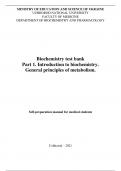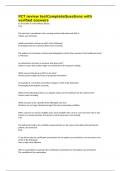MINISTRY OF EDUCATION AND SCIENCE OF UKRAINE
UZHHOROD NATIONAL UNIVERSITY
FACULTY OF MEDICINE
DEPARTMENT OF BIOCHEMISTRY AND PHARMACOLOGY
Biochemistry test bank
Part 1. Introduction to biochemistry.
General principles of metabolism.
Self-preparation manual for medical students
Uzhhorod – 2021
,УДК 577.1(075.8)=111
Упорядники:
- зав. кафедри біохімії та фармакології медичного факультету ДВНЗ «УжНУ», к.мед.н., доц.
Ростока Лариса Михайлівна,
- асистент кафедри біохімії та фармакології медичного факультету ДВНЗ «УжНУ» Бурмістрова
Яна Юріївна
- асистент кафедри біохімії та фармакології медичного факультету ДВНЗ «УжНУ» Сіткар
Андрій Дмитрович
Методична розробка для студентів складено у відповідності з вимогами освітньо-професійної
програми підготовки магістра.
РЕЦЕНЗЕНТИ:
Фабрі З.Й. – д.б.н., професор кафедри біохімії та фармакології медичного факультету ДВНЗ
«УжНУ»
Сірчак Є.С. – д.мед.н., професор, зав. кафедри пропедевтики внутрішніх хвороб медичного
факультету ДВНЗ «УжНУ»
Затверджено на засіданні Вченої ради медичного факултету ДВНЗ «УжНУ»
від 15.11.2021 р., протокол №2.
2
, FOREWORD
In order to improve the preparation of students of higher medical educational institutions
for practical classes in biochemistry and better understending of theoretical material, test
bank in the discipline have been arranged. This manual provides tests of following topics:
structure, properties and functions of informational biomolecules (proteins and nucleic
acids), fundamentals of biological catalisis (enzymes and coenzymes), general principles of
metabolism and common metabolic pathways, biological oxidation and bioenergetics. The
tests are divided into five chapters, each of which includes tasks of different types of
difficulty: multiple choice questions, theoretical questions, writing the missing word,
drawing the structure of biomolecules, situational tasks and questions of higher difficulty
levels. It is important that the organization of situational tasks is related to clinical cases and
practical medicine.
Biological chemistry is a fundamental medical discipline. A perfect understanding of the
theoretical material is the basis for the study of clinical disciplines, interpretation of
laboratory parameters and future medical practice.
3
, Chapter I. Amino acids. Peptides. Proteins.
List of the exam questions:
1. Amino acids: definition, classification (by side-chain polarity, by side-chain functional
group, nutritional classification).
2. Structure of proteinogenic amino acids. Properties of amino acids: chirality of amino
acids, acid-base properties, ability to form peptide bonds.
3. The formation of tripeptide.
4. Nonstandart amino acids: structure and localization.
5. Proteins: definition, functions. Levels of protein structure. Peptide bond properties.
Domain and oligomeric proteins.
6. Physical and chemical properties of proteins. Denaturation of proteins.
7. Protein classification.
8. Common characteristic and biological role of individual classes of proteins: albumins,
globulins, histones, protamins, complex proteins etc.
Multiple Choice Questions:
1. A 30-year-old man has a hypoenergetic state associated with a violation of the functional state of
the cytochromes of the respiratory chain of mitochondria, which by chemical nature are:
a. Hemproteins
b. Glycoproteins
c. Flavoproteins
d. Lipoproteins
e. Retinolproteins
2. A 40-year-old man was hospitalized due to carbon monoxide poisoning. Which of the following
hemoglobin fractions will be elevated in this patient?
a. Carboxyhemoglobin
b. Methemoglobin
c. Carbhemoglobin
d. Oxyhemoglobin
e. Glycosylated hemoglobin
3. A 58-year-old man has signs of atherosclerotic lesions of the cardiovascular system. The increase
in which of the following indicators of biochemical analysis of blood is most characteristic of this
condition?
a. LDL level
b. Chylomicron level
c. LDH5 activities
d. HDL level
e. Pancreatic lipase activities
4. A patient with acute myocardial infarction underwent anticoagulant therapy with an antithrombin
III activator that counteracts intravascular coagulation. Choose a drug.
a. Heparin
4
,b. Hyaluronic acid
c. Chondroitin sulfate
d. Tetracycline
e. Histamine
5. A prosthetic group of complex proteins joins the polypeptide chain through various bonds.
Through which group does the phosphoric acid residue join the proteins in phosphoproteins?
a. OH-group serine
b. CH-group of methionine
c. NH-lysine group
d. SH-group of cysteine
e. COO-glutamine group
6. A structural feature of fibrillar proteins is the formation of multimolecular filamentous complexes
- fibrils, which consist of several parallel polypeptide chains. Name the fibrillar protein that is part
of the hair, skin, nails.
a. Alpha-keratin
b. Albumin
c. Prothrombin
d. Globulin
e. Histon
7. Albumins, blood plasma proteins that are synthesized in the liver and perform certain functions.
Specify one of them:
a. Transport of drugs
b. The formation of blood clots
c. Transport of carbon dioxide
d. Oxygen transport
e. Antibody production
8. Along with normal types of hemoglobin in the body of an adult may be present pathological.
Specify one of them:
a. HbS
b. HbF
c. HbA2
d. HbCO2
e. HbO2
9. Amino acids exhibit:
a. only acidic properties
b. amphoteric properties
c. only basic properties
d. only oxidizing properties
10. Amino acids that are not synthesized in the human body are called:
a. metabolic;
b. synthetic;
c. essential;
d. non-essential.
5
,11. Amino acids that are synthesized in the human body are called:
a. metabolic;
b. synthetic;
c. essential;
d. non-essential.
12. Ammonium sulfate is used in the isolation of enzymes from the homogenate. What method
can be used to purify the enzyme from it?
a. Dialysis
b. Ultracentrifugation
c. Filtering
d. Chromatography
e. Electrophoresis
13. Among the methods used in practice to study metabolism is one that allows the separation,
identification and quantification of substances. Name it.
a. Electrophoresis
b. Spectrophotometry
c. X-ray diffraction analysis
d. Manometry
e. Ultracentrifugation
14. An electrophoretic examination of the patient's serum revealed interferon. In the zone of which
fraction is this protein?
a. Gamma globulins
b. Beta globulins
c. Alpha-2-globulins
d. Alpha-1-globulins
e. Albums
15. As a result of oxidase reactions, hydrogen peroxide is formed, which is a toxic substance for
the body. Glutathione plays an important role in its recovery. Name the amino acids that are part of
glutathione:
a. Glutamic acid, cysteine, glycine
b. Aspartic acid, valine, serine
c. Phenylalanine, lysine, tyrosine
d. Lysine, methionine, tryptophan
e. Isoleucine, histidine, alanine
16. Atherosclerosis is a disease that is associated with impaired metabolism of cholesterol, which
is transported by lipoproteins. Indicate which of the lipoproteins leads to the development of this
disease?
a. LDL
b. HDL
c. VLDL
d. Chylomicrons
e. Triglycerides
6
,17. Atherosclerosis is a disease that is associated with impaired metabolism of cholesterol, which
is transported by lipoproteins. Indicate which of the lipoproteins leads to the development of this
disease?
a. LDL
b. HDL
c. VLDL
d. Chylomicrons
e. Triglycerides
18. Blood tests revealed structural changes in erythrocytes and hemoglobin. Which amino acid
substitution in the hemoglobin beta chain can lead to this?
a. Glutamic acid on valine
b. Aspartic acid on valine
c. Aspartic acid on leucine
d. Glutamic acid on serine
e. Glutamic acid to alanine
19. Both simple and complex proteins are present in the human body. What is the difference in the
structure of complex proteins from simple ones?
a. The presence of a non-protein component
b. Lack of non-protein component
c. Spatial organization of a protein molecule
d. A sequence of amino acid residues
e. The number of amino acid residues
20. Changes in the level of plasma lipoproteins indicate a pathology of lipid metabolism. Elevated
levels of which lipoproteins can lead to the development of atherosclerosis?
a. Low density lipoprotein (beta-LP)
b. High Density Lipoproteins (alpha-LP)
c. Structural lipoproteins
d. Chylomicrons
e. Medium Density Lipoproteins
21. Choose from the following amino acids non-essential:
a. Tryptophan
b. Methionine
c. Valine
d. Lysine
e. Glutamate
22. Choose from the list of hemoprotein:
a. Catalase
b. Chondroitin sulfuric acid
c. Hyaluronic acid
d. Ikhtulin
e. Vitelin
23. Choose from the list of phosphoproteins:
a. Catalase
7
, b. Hemosiderin
c. Transferrin
d. Interferon
e. Caseinogen
24. Choose the correct continuation of the phrase : "Essential amino acids" are those that ...:
a. Positively charged
b. Negatively charged
c. Synthesized in the body
d. Not synthesized in the body
e. No charge
25. Choose the definition of "denaturation":
a. Destruction of disulfide bonds in the tertiary structure
b. Destruction of hydrogen bonds in the secondary structure
c. Destruction of all levels of organization of the protein molecule, except the primary structure
d. Destruction of the primary structure of the protein to amino acids
e. Destruction of the Quaternary structure to the Tertiary
26. Cyanides are strong poisons for the human body. Which connection would be best to connect
them?
a. Methemoglobin
b. Carboxyhemoglobin
c. Carbhemoglobin
d. Oxyhemoglobin
e. Gem
27. Cytochrome C is used to improve tissue respiration in neonatal asphyxia and to restore
oxidative processes in the body. To which class of substances does this compound belong?
a. Hemoproteins
b. Phosphoproteins
c. Nucleoproteins
d. Lipoproteins
e. Glycoproteins
28. Dietary protein is called complete if it contains all available:
a. essential amino acids;
b. non-essential amino acids;
c. metabolic amino acids;
d. non-metabolic amino acids.
29. Dietary protein is called defective if it does not contain all available:
a. essential amino acids;
b. non-essential amino acids;
c. metabolic amino acids;
d. non-metabolic amino acids.
8





